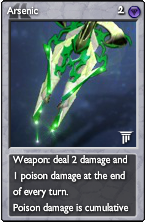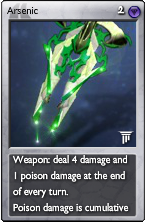Arsenic
|
|
Contents
Overview
The rare Death card, Arsenic, is a dangerous card. Compared to the other weapons, it does a small amount of damage (either 2 damage unupped or 4 damage upgraded), but where it shines is its ability. In addition, Arsenic also adds 1 poison counter to the opponent upon hitting the enemy, making it a potent device when it comes to applying poison.
General Use
Quick Facts:
- Arsenic deals 2 damage (or 4 damage when upgraded), and afflicts one poison damage (adds a poison counter) to the opponent; the poison can only be applied if Arsenic manages to hit the opponent
- The poison damage from the weapon can be stacked with all other poison effects, and can be reapplied each turn upon attacking
- Has the Poisonous passive when flown
Arsenic is a specialized weapon for dealing damage over time, compared to some of the other tougher weapons, such as Titan or Fahrenheit, which deal huge chunks of damage upon being played. When Arsenic manages to successfully deal damage to the opponent directly, its Venom ability applies one poison counter on the opponent. The next turn, the opponent takes 1 more damage from the poison. This doesn’t seem like much initially, but the impact of the poison can become a crippling effect if your opponent is unable to remove Arsenic or continuously heal to counteract the poison. Since poison is cumulative, Arsenic can rack up several poison counters on an opponent if played early, which will slowly chip away at the enemy’s health if they’re not quick enough. Even if Arsenic gets destroyed or stolen, the poison damage is still in effect. Also, the cost is incredibly efficient; 2 ![]() to play either version (non-upgraded or upped). Because of that, having multiple Arsenics in a deck can annoy an opponent with limited permanent control (PC), as Arsenic is generally cheaper than most PC (Steal, Pulverizer, and Butterfly Effect).
to play either version (non-upgraded or upped). Because of that, having multiple Arsenics in a deck can annoy an opponent with limited permanent control (PC), as Arsenic is generally cheaper than most PC (Steal, Pulverizer, and Butterfly Effect).
Its major weaknesses besides permanent control are shields that are defensive enough to block the attack completely (Bone Wall, Dissipation Shield) or having it completely miss (Dusk Mantle, Improved Fog). If Arsenic cannot hit the opponent, another poison counter can’t be applied. Also, Purify (a Water spell that costs 1 ![]() ) can utterly negate all of the poison damage by removing all of the poison counters. However, not every deck carries such shields or that specific spell.
) can utterly negate all of the poison damage by removing all of the poison counters. However, not every deck carries such shields or that specific spell.
Synergies
 One of the most common uses for Arsenic is in a Speed Poison type deck, where the goal is to put as many poison counters on the opponent as fast as possible. In most cases, players tend to assume that the enemy cannot remove the poison counters by packing a Purify in the deck, so they try to place as many poison-related cards in the deck. Obviously, the Poison | Deadly Poison cards are incredibly cheap spells that help rack poison counters on the opponent, so in most poison-decks, Arsenic and Poison are often paired up together.
One of the most common uses for Arsenic is in a Speed Poison type deck, where the goal is to put as many poison counters on the opponent as fast as possible. In most cases, players tend to assume that the enemy cannot remove the poison counters by packing a Purify in the deck, so they try to place as many poison-related cards in the deck. Obviously, the Poison | Deadly Poison cards are incredibly cheap spells that help rack poison counters on the opponent, so in most poison-decks, Arsenic and Poison are often paired up together.
Chrysaora | Physalia are incredibly cheap creatures (1 ![]() ) with the ‘ Poison’ ability, which can help load poison counters on the opponent quickly alongside an Arsenic. Puffer Fish can also apply poison using their ‘Venom’ attacks; both of these creatures create a specialized synergy between Death and Water via the use of poison and slow damage over time to control the battlefield. Scorpio, the False God, uses these strategies to overwhelm players with poison counters.
) with the ‘ Poison’ ability, which can help load poison counters on the opponent quickly alongside an Arsenic. Puffer Fish can also apply poison using their ‘Venom’ attacks; both of these creatures create a specialized synergy between Death and Water via the use of poison and slow damage over time to control the battlefield. Scorpio, the False God, uses these strategies to overwhelm players with poison counters.
Lastly, Flying Weapon | Animate Weapon is another effective card with Arsenic - by having multiple Arsenics on the field (Flying Weapon turns the weapon into a creature), you can have multiple applications of poison while also ignoring nasty permanent control; Arsenic has 7 HP in both forms, making it fairly resistant towards most damaging creature control effects. In addition, it also has the ‘poisonous’ passive, giving it some resistance towards Otyugh and Scarab decks that tend to Devour creatures (if a creature consumes the Arsenic, they’ll be infected with poison as well).
Other Cards With Synergy
Because of its slow nature, many players usually combine Arsenic in decks as supplemental damage (rainbows) or focus on Arsenic as the main fighter with stalling cards (Sundial, Miracle, Bone Wall). Mono-death strategies also rely heavily on this card as support damage; such decks will usually contain powerful death creatures such as Flesh Recluse or Bone Dragon to deal massive amounts of direct damage while the poison whittles the health away.
Conclusion
With various creatures, spells, and permanents that can apply poison to your enemy and/or their creatures, it’s important to note that poison often takes time to whittle down your opponent. Despite having a couple of hard counters, Arsenic is an iconic weapon for Death due to its toxic gift, and one that is loved and hated by anyone who knows the nature of poison.
Popular Deck

4vi 4vj 4vj 4vj 4vj 4vj 4vj 52o 52o 52o 52o 52o 52q 52q 52q 52q 595 5f6 5i5 5i7 5oi 5oi 5oi 5rp 5rp 5rp 5rp 5rp 5rp 61q 8pk




